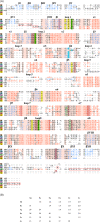Crystal structure of Methanococcus jannaschii dihydroorotase
- PMID: 35978488
- PMCID: PMC9771888
- DOI: 10.1002/prot.26412
Crystal structure of Methanococcus jannaschii dihydroorotase
Abstract
In this paper, we report the structural analysis of dihydroorotase (DHOase) from the hyperthermophilic and barophilic archaeon Methanococcus jannaschii. DHOase catalyzes the reversible cyclization of N-carbamoyl-l-aspartate to l-dihydroorotate in the third step of de novo pyrimidine biosynthesis. DHOases form a very diverse family of enzymes and have been classified into types and subtypes with structural similarities and differences among them. This is the first archaeal DHOase studied by x-ray diffraction. Its structure and comparison with known representatives of the other subtypes help define the structural features of the archaeal subtype. The M. jannaschii DHOase is found here to have traits from all subtypes. Contrary to expectations, it has a carboxylated lysine bridging the two Zn ions in the active site, and a long catalytic loop. It is a monomeric protein with a large β sandwich domain adjacent to the TIM barrel. Loop 5 is similar to bacterial type III and the C-terminal extension is long.
Keywords: Methanococcus jannaschii; crystal structure; dihydroorotase; pyrimidine biosynthesis.
© 2022 The Authors. Proteins: Structure, Function, and Bioinformatics published by Wiley Periodicals LLC.
Conflict of interest statement
The authors declare no potential conflict of interest.
Figures


Similar articles
-
Aquifex aeolicus dihydroorotase: association with aspartate transcarbamoylase switches on catalytic activity.J Biol Chem. 2004 Dec 17;279(51):53136-44. doi: 10.1074/jbc.M403009200. Epub 2004 Sep 20. J Biol Chem. 2004. PMID: 15381710
-
Characterization of the catalytic flexible loop in the dihydroorotase domain of the human multi-enzymatic protein CAD.J Biol Chem. 2018 Dec 7;293(49):18903-18913. doi: 10.1074/jbc.RA118.005494. Epub 2018 Oct 12. J Biol Chem. 2018. PMID: 30315107 Free PMC article.
-
Ca-asp bound X-ray structure and inhibition of Bacillus anthracis dihydroorotase (DHOase).Bioorg Med Chem. 2016 Oct 1;24(19):4536-4543. doi: 10.1016/j.bmc.2016.07.055. Epub 2016 Jul 29. Bioorg Med Chem. 2016. PMID: 27499369 Free PMC article.
-
The Loop-In Binding Mode of Dihydroorotase: Implications for Ligand Binding and Therapeutic Targeting.Int J Mol Sci. 2025 Feb 6;26(3):1359. doi: 10.3390/ijms26031359. Int J Mol Sci. 2025. PMID: 39941127 Free PMC article. Review.
-
CAD, A Multienzymatic Protein at the Head of de Novo Pyrimidine Biosynthesis.Subcell Biochem. 2019;93:505-538. doi: 10.1007/978-3-030-28151-9_17. Subcell Biochem. 2019. PMID: 31939163 Review.
References
-
- Cooper C, Wilson DW. Biosynthesis of pyrimidines. Fed Proc. 1954;13:194.
-
- Lieberman I, Kornberg A. Enzymatic synthesis and breakdown of a pyrimidine, orotic acid. I. Dihydroorotic acid, ureidosuccinic acid, and 5‐carboxymethylhydantoin. J Biol Chem. 1954;207:911‐924. - PubMed
-
- Holm L, Sander C. An evolutionary treasure: unification of a broad set of amidohydrolases related to urease. Proteins. 1997;28:72‐82. - PubMed
-
- Fields C, Brichta D, Shepherdson M, Farinha M, O'Donovan G. Phylogenetic analysis and classification of dihydroorotases: a complex history for a complex enzyme. Paths Pyrimidines. 1999;7:49‐63.
-
- Thoden JB, Phillips GN Jr, Neal TM, Raushel FM, Holden HM. Molecular structure of dihydroorotase: a paradigm for catalysis through the use of a binuclear metal center. Biochemistry. 2001;40:6989‐6997. - PubMed
Publication types
MeSH terms
Substances
Grants and funding
LinkOut - more resources
Full Text Sources

